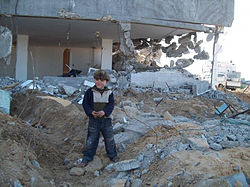Jabaliya
| Jabalia | |
|---|---|
| Other transcription(s) | |
| • Arabic | جباليا |
| • Also spelled | Jabalya (official) |

House in Azbet, Jabalia, destroyed by Israel in 2009
|
|
| Location of Jabalia within the Palestinian territories | |
| Coordinates: 31°31′41″N 34°28′59″E / 31.52806°N 34.48306°ECoordinates: 31°31′41″N 34°28′59″E / 31.52806°N 34.48306°E | |
| Palestine grid | 100/103 |
| Governorate | North Gaza |
| Government | |
| • Type | City |
| Population (2006) | |
| • Jurisdiction | 82,877 |
| Name meaning | "The mountaineers" |
Jabalia also Jabalya (Arabic: جباليا) is a Palestinian city located 4 kilometers (2.5 mi) north of Gaza City. It is under the jurisdiction of the North Gaza Governorate, in the Gaza Strip. According to the Palestinian Central Bureau of Statistics, Jabalia had a population of 82,877 in mid‑2006. The Jabalia refugee camp is adjacent to the city to the north. The nearby town of Nazla is a part of the Jabalia municipality. The city is currently ruled by a Hamas administration.
A large cemetery dating to the 8th century CE was found near Jabalia. The workmanship indicates that the Christian community in Gaza was still very much in existence in the early Islamic era of rule in Palestine, and capable of artistic achievements. The remains of the pavement spared by the iconoclasts show depictions of wild game, birds, and country scenes. The late dating of the mosaic pavement proves that the intervention of the iconoclasts, after 750, is later than previously thought and is associated with Abbasid conservatives.
While working on the Salah al-Din Road, laborers accidentally uncovered a monastery from the Byzantine period. The site was excavated by the Palestinian Department of Antiquities. Now the stunning Byzantine mosaics of the monastery are covered with sand to shield them from erosion caused by the direct impact of the winter rain. Byzantine ceramics have also been found.
Jabalia was known for its fertile soil and citrus trees. The Mamluk Governor of Gaza Sanjar al-Jawli ruled the area in the early 14th-century and endowed part of Jabalia's land to the al‑Shamah Mosque he built in Gaza. In Jabalia is the medieval Omeri Mosque. No structures from the ancient part of the mosque remain, except the portico and minaret. The rest of the mosque is of modern construction. The portico consists of three arcades supported by four stone columns. The arcades have pointed arches and the portico is covered by crossing vaults.
...
Wikipedia

